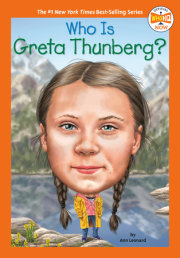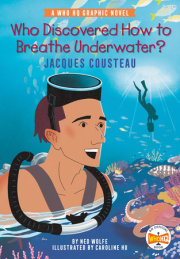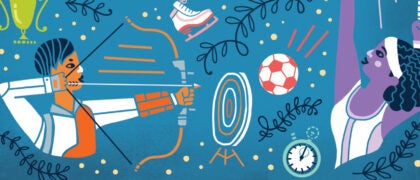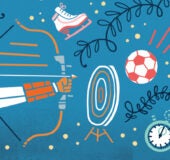Who Is Katie Ledecky? BONNNG! It was the women’s 800-meter freestyle race at the 2012 Summer Olympics in London, and the electronic starting signal had just sent the swimmers diving into the water. Eight competitors would speed through sixteen laps in the 50--meter pool. The water splashed high into the air as the athletes swung their arms quickly. White water churned behind them as they kicked hard over and over. When they reached each end of the pool, the swimmers did a flip, pushed off the wall, and started back.
Many of the fans who had packed into the London Aquatics Centre were born and raised in England. They were cheering for Rebecca Adlington of Great Britain, who was favored to win. She had won the gold medal in the 2008 Games and planned to defend her title. By the third lap, though, another one of the swimmers began to edge ahead of the rest. It was Katie Ledecky from the United States, and her lead grew as the athletes continued, lap after lap. With each stroke, Katie got closer to victory, even as the crowd cheered for her rival.
As she turned toward the last lap, the surprise star was far in the lead. When Katie finally touched the wall at the finish, she had set a new American record. She looked up, water dripping off her swim cap. She pulled off her goggles and looked at the scoreboard with a big smile that would soon become world-famous. She had won! At only fifteen years old, she was an Olympic champion, the second--youngest American woman ever to win an individual gold in any event! She waved at her parents, who were cheering in the stands.
“I went out fast,” Katie said afterward. “I was able to hold on, and that’s what I’ve been working on. I didn’t really expect gold, but I’ll take it!”
That work had started when Katie was six years old, and her continued dedication has led to one of the greatest careers in swimming history. Katie has gone from being a teen star to a seasoned veteran. Along the way, she has inspired young swimmers and teammates alike with her positive attitude and fierce determination. Let’s dive in and meet one of the world’s greatest swimmers!
Chapter 1 Future Olympian Kathleen Ledecky was born in Washington, DC, on March 17, 1997, and grew up in Bethesda, Maryland. Her father, David, and the rest of her family quickly nicknamed her Katie. The Ledeckys enjoyed swimming, partly because Katie’s mother, Mary Gen, had been a swimmer in college. Katie’s older brother, Michael, was the first to take part in swimming races. When Katie turned six, she joined Michael at the Palisades Swim & Tennis Club near the family home. A video of six-year-old Katie shows her after her first race saying that she could not wait to race again!
Swimming was not the only sport in Katie’s life. She also enjoyed watching baseball and hockey. Her uncle, Jon, was part--owner of the Washington Capitals hockey team, so she would often go to their games, hoping to see her favorite player, Adam Oates. While attending one of these games, Katie began playing peekaboo with another fan who was sitting behind her in the stands. It turned out to be National Basketball Association (NBA) legend Michael Jordan!
But Michael Jordan was not the only famous athlete Katie met when she was a child. At a swim meet when she was very young, Katie met and got an autograph from Michael Phelps, a world champion swimmer who also grew up in Maryland. For young Katie, he became an inspiration.
Michael Phelps Like Katie Ledecky, Michael Phelps grew up in Maryland and became an international swimming star. He made his first Olympic swim in the 200-meter butterfly in 2000, but he didn’t win. In 2004, he won six gold and two bronze medals, swimming freestyle, butterfly, relays, and individual medley (medley events feature a mix of swimming styles). Four years later, at the Summer Olympics in Beijing, Michael did something no one had ever done: He won eight gold medals at one game. He also set world records in seven of those events. He added four golds and two silvers to his collection after competing in the games in 2012. For a while, Michael retired from the sport and focused on improving his mental health. But once he felt better, he decided to come back for one last time and won five more golds and a silver medal at the 2016 Summer Olympic Games. Michael Phelps has won twenty-eight total Olympic medals, twenty-three of which are gold, making him the most decorated Olympic athlete in history. She would get another autograph from Michael Phelps three years later. By that time Michael had become a sixtime Olympic gold medalist, and he would go on to set a record for the most Olympic medals of all time.
Katie made time for other fun activities, including Irish dancing, soccer, and basketball. But she quickly found herself choosing swim practice over basketball practice if they were set at the same time. One day in fourth grade while playing basketball in gym class, Katie broke her arm. But instead of waiting until her arm was healed to swim again, she would wrap her cast in a plastic bag and kick with a kickboard in the water. Katie’s passion for swimming was undeniable.
As Katie took part in more and more swim competitions, she showed the focus and dedication that would later make her a superstar. When she was only six, she began writing down swimming goals. At first, she put sticky notes on her dresser: Swim a whole lap. Reach a certain time. As her swimming improved, she wrote down more times that she wanted to aim for in different races. Katie and her brother Michael spent almost every weekend in the pool, practicing and trying to improve.
Katie joined the Nation’s Capital Swim Club, where she was first coached by Yuri Suguiyama and later Bruce Gemmell. By the time Katie was in junior high, she was often beating swimmers who were in high school or college. Her coaches could see that she was something special. “Something drives them to be better every day. . . I really don’t know that it drives them to be better than their competition. I think it is something that drives them to be better than themselves,” said Gemmell about athletes like Katie.
In 2011, when Katie was fourteen, she won three events at the National Junior Championships. She was only a freshman at her high school, Stone Ridge School of the Sacred Heart, but her coaches thought she had a chance to swim in the 2012 Olympics, which would be held in London, England. Her times were good enough to earn her a spot in the 2012 US Olympic trials, an event that would be held at the end of June in Omaha, Nebraska. Athletes who performed well at that event would be selected for the US Olympic swim team.
About forty of Katie’s family members came from around the country to watch her race in the trials. Most people figured that this would be the highlight of Katie’s summer, just getting the chance to race among the nation’s best
swimmers.
In the 400meter freestyle, Katie finished third—not high enough to win a spot on the team, though her time was America’s best ever for someone aged sixteen and under. Next up was a longer race, 800 meters—sixteen laps of the 50-meter pool. It’s a tough race that calls for both speed and stamina.
Katie got out in front quickly, ahead of Kate Ziegler, an older and more accomplished swimmer. To everyone’s surprise, Katie won the 800-meter trial. She had made the US Olympic team! Her time of just less than 8 minutes and 20 seconds was also a new US Olympic trials record. “I knew she’d be able to do something special at Olympic trials,” Coach Suguiyama said later. “I always tried to remind her: ‘You belong here. This is your level.’ ”
While her Stone Ridge classmates went off on summer vacation, Katie Ledecky headed to London to go for the gold.
Olympic Swimming Swimming is one of only five sports that have been part of every modern Summer Olympic Games since 1896. (The other four are cycling, fencing, gymnastics, and track and field.) Swimming events for women did not begin until 1912. Until 1908, Olympic swimming events were held in open water, including oceans, rivers, or lakes. In 2008, the Olympics brought back open--water swimming with a 10-kilometer event. In the Summer Olympics today, swimmers compete in an indoor pool that is 50 meters long. Race distances range from 50 meters (one lap) to 1,500 meters (thirty laps). Some races are relays in which teams of four swimmers take turns. The rest are individual events. There are four different strokes used in Summer Olympic races. In freestyle, swimmers alternate arm swings while kicking with their legs. In butterfly, the legs and arms each kick or swing together. In breaststroke, the hands come together and push backward in the water, while the legs do a frog--like kick. Backstroke is the only stroke done facing upward. While the swimmer kicks, they rotate each arm one at a time.
Copyright © 2024 by Penguin Random House LLC. All rights reserved. No part of this excerpt may be reproduced or reprinted without permission in writing from the publisher.


































































































































